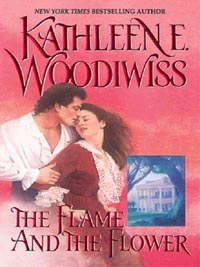Romance novel
A romance novel is a literary genre developed in Western culture, mainly in English-speaking countries. Novels in this genre place their primary focus on the relationship and romantic love between two people, and must have an "emotionally satisfying and optimistic ending." Through the late 20th and early 21st centuries, these novels are commercially in two main varieties: category romances, which are shorter books with a one-month shelf-life, and single-title romances, which are generally longer with a longer shelf-life. Separate from their type, a romance novel can exist within one of many subgenres, including contemporary, historical, and paranormal.
It is often claimed that the modern romance genre was born in 1972 with Avon's publication of Kathleen Woodiwiss's The Flame and the Flower, the first single-title romance novel to be published as an original paperback in the US, though in the UK the romance genre was long established through the works of Georgette Heyer, Catherine Cookson and others. Nancy Coffey was the senior editor who negotiated the multi-book deal. The genre boomed in the 1980s, with the addition of many category romance lines and an increased number of single-title romances. Popular authors began pushing the boundaries of the genre and plots, and characters began to modernize.
In North America, romance novels are the most popular genre in modern literature, comprising almost 55% of all paperback books sold in 2004. The genre is also popular in Europe and Australia, and romance novels appear in 90 languages. Most of the books, however, are written by authors from English-speaking countries, leading to an Anglo-Saxon perspective in the fiction. Despite the popularity and widespread sales of romance novels, the genre has attracted significant derision, skepticism and criticism.
The success of these novels prompted a new style of writing romance, concentrating primarily on historical fiction tracking the monogamous relationship between a helpless heroine and the hero who rescued her, even if he had been the one to place her in danger. The covers of these novels tended to feature scantily clad women being grabbed by the hero, and caused the novels to be referred to as "bodice rippers." A Wall St. Journal article in 1980 referred to these bodice rippers as "publishing's answer to the Big Mac: They are juicy, cheap, predictable, and devoured in stupefying quantities by legions of loyal fans." The term bodice ripper is now considered offensive to many in the romance industry.
In this new style of historical romance, heroines were independent and strong-willed and were often paired with heroes who evolved into caring and compassionate men who truly admired the women they loved. This was in contrast to the contemporary romances published during this time, which were often characterized by weak females who fell in love with overbearing alpha males. Although these heroines had active roles in the plot, they were "passive in relationships with the heroes." Across the genre, heroines during this time were usually aged 16–21, with the heroes slightly older, usually around 30. The women were virgins, while the men were not, and both members of the couple were described as beautiful.
Erotic romance
Erotic romance, sometimes called romantica, is a blend of romance and erotica. Erotic romance novels are characterized by strong sexual content, but can contain elements of any of the other romance subgenres. Erotic romance novels tend to use more frank language, avoiding many of the euphemisms used in books with milder content. These novels also usually include more sex scenes, often focusing more on the sex act rather than being a more traditional love scene, and may include more unusual positions or acts. Despite a greater emphasis on the sex scenes, however, erotic romance is not to be confused with pornography. While pornography would concentrate solely on the sex acts, erotica novels include well-developed characters and a plot which could exist without the sex acts.
Erotic romances lengths run from short stories to single-title novels. Some of these are published as part of a category, such as Harlequin Blaze, while others are published as part of an anthology and are only novella length. Even single-title erotic romances may be as short as a novella, however.
Many of the publishers of erotic romance are either small press publishers or electronic book publishers. Writers often have more leeway in what types of erotic acts can be included when working with an electronic publisher than they would have working with a print publisher. The market for erotic romances has been growing rapidly, leading some publishers to create new lines for these types of books. Some subjects are still considered taboo, even with erotic romance. Themes such as pedophilia, incest, and bestiality are discouraged by all publishers.
The market for erotic romances has been growing rapidly. "Ellora's Cave", an electronic publisher which focuses on erotic romance, became the first electronic publisher to be recognized by the Romance Writers of America as a legitimate publisher.
- Also see the page [ Romance novel ] on Wikipedia
Chat rooms • What links here • Copyright info • Contact information • Category:Root
